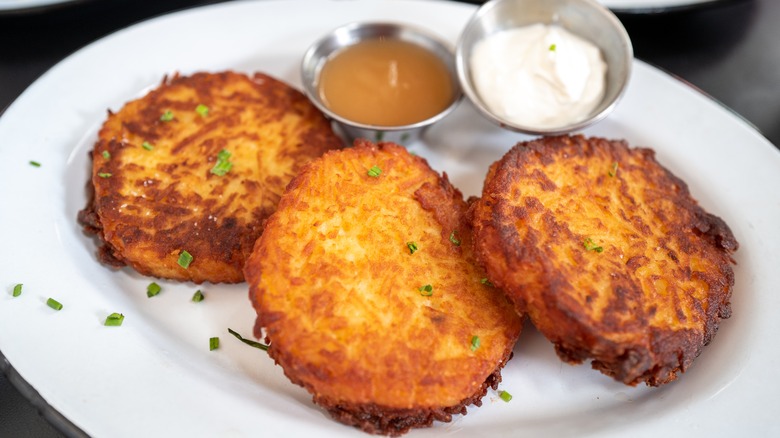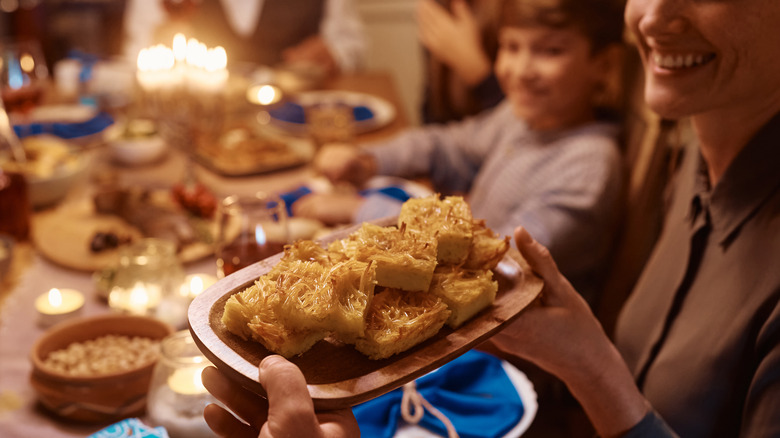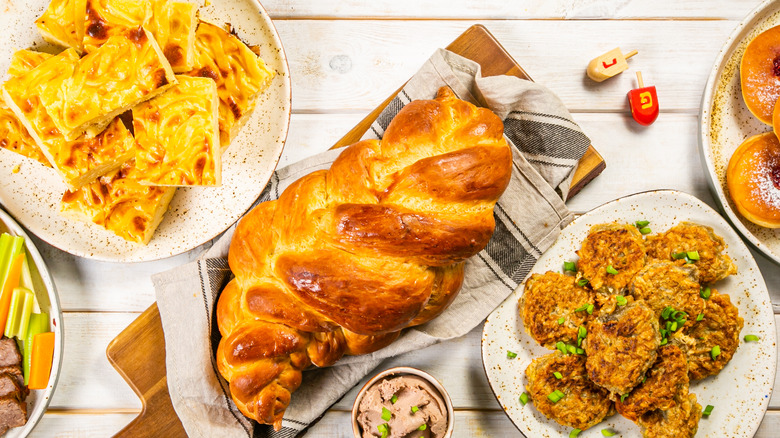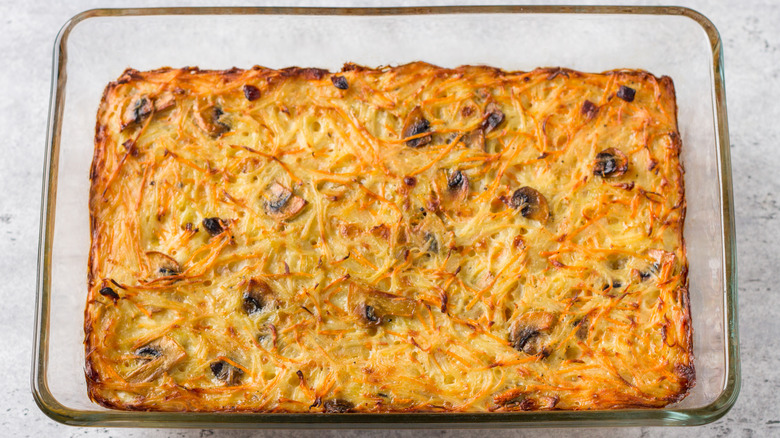The Key Differences Between Latkes And Kugel
The most famous examples of Jewish cuisine in the U.S. trace to New York City, recalling dishes like iconic pastrami sandwiches and bagels with lox. However, that's only one sliver of the Jewish foods on offer. With such a wide diaspora of Jewish people, traditional Jewish foods draw on a large source of culinary influences, covering many diverse dishes.
Especially with Ashkenazi Jewish cuisine, influences stem from European culinary traditions from a large region. A rich array of dishes emerged from Eastern European countries like Ukraine and Poland, all the way west to Italy, Germany, and France.
Among them are centuries-old celebration favorites, latkes, and kugel. The former are crispy potato pancakes, around since 14th-century Italy, and particularly enjoyed on Hanukkah. While the latter is a casserole-like creation for Passover crafted with either noodles or potatoes, coming by way of Germany. Both dishes encompass a rich fusion of adjustments over centuries, and are now beloved at celebrations as tasty, comforting fare.
What are latkes?
Classic latkes are a well-loved Jewish celebration staple crafted from shredded potatoes and then pan-fried. They come in a wide array of forms, with each family spinning the dish with their unique rendition. At their most fundamental, they are made of shredded potatoes flavored with onions for sweetness and bound together with eggs and flour, often of the matzo variety. They're then pan-fried to a golden crispy consistency, yielding a crunchy outside with a soft interior. The cooking fat is an essential cornerstone of the dish, with poultry-based schmaltz a traditional choice but vegetable oil employed, too.
Past being crisp, comforting fare, latkes encompass a deep-rooted tradition. Frying foods pancake-style is a preparation technique that's long been intertwined with Hanukkah celebrations. They're mentioned in a poem by a rabbi with reference to the holiday as far back as 1322. And evidence from Jews residing in Italy mentions that the earliest fried pancakes came together with ricotta. It wasn't until the advent of potatoes from the New World into Europe in the 16th century that the modern version took hold.
What is kugel?
Kugel is a form of a casserole, typically made with egg noodles, but can have a potato-based composition, too. Kugel has a more custard-like consistency, created by the pairing of fat and eggs, which envelope the starch. The dish can be either sweet or savory, with noodle bases typically contributing to the former, while potatoes make a delicious side dish alongside entrees.
Flavors run a gamut of possibilities, with sweet kugel often using sour cream, cottage cheese, and butter paired with cinnamon and dried fruits. Oftentimes, there's a crispy topping, like crushed graham crackers or cornflakes. Meanwhile, savory versions rely on onions and garlic for aromatics, paired with meats, herbs, and root vegetables.
Despite its affiliation with pasta, kugel's debated origins point towards Germany. It started as a bread-pudding-like creation and, for the first centuries of its existence, carried a savory flavor. Noodle influences came from Italy and Asia, and sweet kugels spun off with the creation of beet sugar, since cane-based sweeteners were expensive. Today, Jewish communities in different places craft kugel in their own distinct, sweet or savory renditions, hence the dish's variety. In the U.S., the dessert variant has become more popular.
Kugel and latkes have distinct consistencies
Both Jewish dishes rely on a combination of eggs, fat, and starch to craft a comforting meal. However, the preparation method lends to completely distinct results. In the case of kugel, the eggs and dairy are mixed together, forming a base. The noodles or potatoes and variable seasonings are mixed in, and the oven-baked result is a thick, casserole-like dish, which is sliced into pieces. Kugel is rich and filling, with crispiness only sometimes a feature. It can be eaten both hot or cold.
In the case of latkes, it's all about the delectable crunch. The frying fat is a traditional cornerstone of the dish, and is the secret to their golden brown result. The eggs and starch act as a binder, combined with thinly shredded potatoes and onions, which stay a touch soft on the inside. Latkes are super comforting, enjoyed piping hot alongside a topping like sour cream.
Kugel and latkes both come in many variations
Despite their differences in taste, both dishes share a common trait: A whole world of variation. They can take on sweet as well as savory forms and incorporate many different flavors. Latkes are more dependably savory but, nowadays, some abandon their foundational tuber altogether. They come made with a multitude of root vegetables, including squash, parsnips, beets, kohlrabi, and zucchini.
The texture is another point of experimentation, with some potato-version recipes calling for roasting or boiling the spuds for varying degrees of softness. Regardless, their patty-like form is the perfect canvas for creative seasoning approaches incorporating many flavorings, including fresh herbs, nuts, cheeses, and spices.
Kugels' differing forms are all considered a traditional take on the dish, depending on where you are. Whether it's Israel's caramel and black pepper noodle kugel or a Lithuanian spin-off called kugelis made with potatoes, condensed milk, and, surprisingly, bacon, international interpretations abound. Some modern versions skip the classic bases completely, employing matzo flour, traditional matzo crackers, or farfel. Possible flavor combinations run wild, with herbs, aromatics, varying fruit, and cheese — like creamy takes with ricotta or gooier ones with Swiss — finding their way into the mix. Just like latkes, kugel is the perfect canvas for new flavors, making it a traditional food with a neverending option of reinterpretation.




